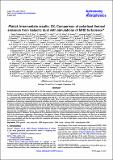Por favor, use este identificador para citar o enlazar a este item:
http://hdl.handle.net/10261/140094COMPARTIR / EXPORTAR:
 SHARE SHARE
 CORE
BASE CORE
BASE
|
|
| Visualizar otros formatos: MARC | Dublin Core | RDF | ORE | MODS | METS | DIDL | DATACITE | |

| Título: | Planck intermediate results. XX. Comparison of polarized thermal emission from Galactic dust with simulations of MHD turbulence |
Autor: | Ade, P. A. R.; Barreiro, R. Belén CSIC ORCID ; Curto, Andrés CSIC; Diego, José María CSIC ORCID ; González-Nuevo, J. CSIC ORCID; López-Caniego, M. CSIC ORCID; Martínez-González, Enrique CSIC ORCID ; Toffolatti, L. CSIC ORCID; Vielva, Patricio CSIC ORCID ; Rebolo López, Rafael CSIC ORCID; Levrier, F.; Planck Collaboration | Palabras clave: | Dust, extinction ISM: general ISM: magnetic fields ISM: clouds Infrared: ISM Submillimeter: ISM |
Fecha de publicación: | 2015 | Editor: | EDP Sciences | Citación: | Astronomy and Astrophysics 576: A105 (2015) | Resumen: | Polarized emission observed by Planck HFI at 353 GHz towards a sample of nearby fields is presented, focusing on the statistics of polarization fractions p and angles ψ. The polarization fractions and column densities in these nearby fields are representative of the range of values obtained over the whole sky. We find that: (i) the largest polarization fractions are reached in the most diffuse fields; (ii) the maximum polarization fraction pmax decreases with column density NH in the more opaque fields with NH> 1021 cm-2; and (iii) the polarization fraction along a given line of sight is correlated with the local spatial coherence of the polarization angle. These observations are compared to polarized emission maps computed in simulations of anisotropic magnetohydrodynamical turbulence in which we assume a uniform intrinsic polarization fraction of the dust grains. We find that an estimate of this parameter may be recovered from the maximum polarization fraction pmax in diffuse regions where the magnetic field is ordered on large scales and perpendicular to the line of sight. This emphasizes the impact of anisotropies of the magnetic field on the emerging polarization signal. The decrease of the maximum polarization fraction with column density in nearby molecular clouds is well reproduced in the simulations, indicating that it is essentially due to the turbulent structure of the magnetic field: an accumulation of variously polarized structures along the line of sight leads to such an anti-correlation. In the simulations, polarization fractions are also found to anti-correlate with the angle dispersion function . However, the dispersion of the polarization angle for a given polarization fraction is found to be larger in the simulations than in the observations, suggesting a shortcoming in the physical content of these numerical models. In summary, we find that the turbulent structure of the magnetic field is able to reproduce the main statistical properties of the dust polarization as observed in a variety of nearby clouds, dense cores excluded, and that the large-scale field orientation with respect to the line of sight plays a major role in the quantitative analysis of these statistical properties. | Descripción: | et al. | Versión del editor: | http://dx.doi.org/10.1051/0004-6361/201424086 | URI: | http://hdl.handle.net/10261/140094 | DOI: | 10.1051/0004-6361/201424086 | Identificadores: | doi: 10.1051/0004-6361/201424086 e-issn: 1432-0746 issn: 0004-6361 |
| Aparece en las colecciones: | (IFCA) Artículos |
Ficheros en este ítem:
| Fichero | Descripción | Tamaño | Formato | |
|---|---|---|---|---|
| Planck XX.pdf | 12,44 MB | Adobe PDF |  Visualizar/Abrir |
CORE Recommender
SCOPUSTM
Citations
36
checked on 16-abr-2024
WEB OF SCIENCETM
Citations
50
checked on 25-feb-2024
Page view(s)
169
checked on 19-abr-2024
Download(s)
147
checked on 19-abr-2024
Google ScholarTM
Check
Altmetric
Altmetric
NOTA: Los ítems de Digital.CSIC están protegidos por copyright, con todos los derechos reservados, a menos que se indique lo contrario.
